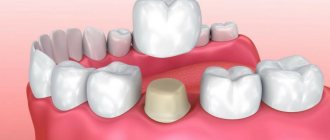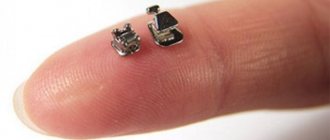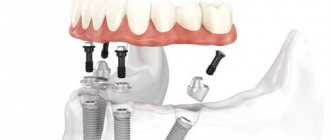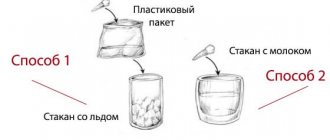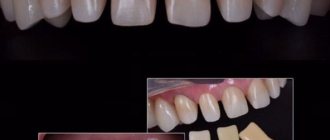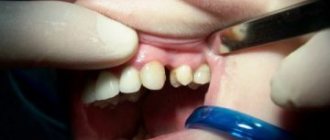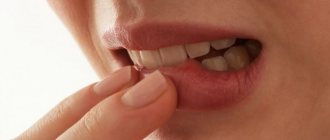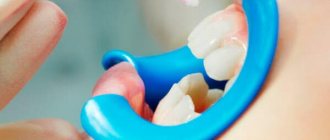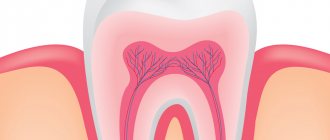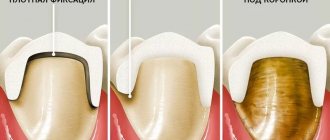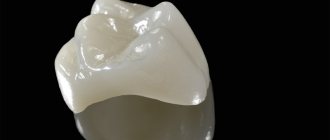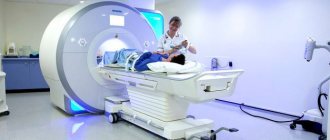The crown part of the front tooth is broken
If a front tooth is partially fractured, veneers or crowns can be used.
Veneers restore tooth function, protect dentin from external influences, and also the aesthetics of a smile. Treatment is only suitable for slightly damaged teeth. If the dental crown is severely damaged, the dentist will suggest installing a ceramic crown.
Crowns are placed on the remaining part of the tooth after grinding and preparing the surrounding area around the damaged tooth. If a significant part of the tooth has broken off, then to securely fix the crown it will be necessary to make a stump inlay, and in this case the tooth will have to be depulped (remove the nerve and fill the root canal).
The main stages of tooth restoration using a crown:
- Drawing up and agreeing on a treatment plan;
- Next, the doctor grinds the tooth down for a crown;
- Taking a silicone impression. The impression is sent to the dental laboratory. Based on the impression, the technicians reconstruct a plaster model of the teeth, and the technician will model the crown on it;
- When the crown is made, it is tried on and, if there is no discomfort, fixed on the stump.
To close the aesthetic defect, until the permanent crown is made, I install temporary plastic crowns on the patient, which can be made either in the laboratory or in the clinic.
Material for making dental crowns .
Front teeth are a person’s calling card. When smiling, in conversation, every person involuntarily exposes his front teeth. Their beauty and health attract their interlocutor. This is why choosing the type of crown for teeth in the smile area is so important. The main types of permanent dental crowns are metal-ceramics, metal-free ceramics and ceramics with a zirconium dioxide frame. The most preferable material, from an aesthetic point of view, for the manufacture of dental crowns for the front teeth is metal-free ceramics e.max or feldspathic ceramics, also ceramics with a zirconium dioxide frame.
Causes
Teeth most likely to break are previously treated teeth with large cavities or with pulp removed.
Cracks and chips appear during impacts and increased loads. But even minor impacts can cause injury if the enamel is weakened. Factors that provoke breakdown include:
- Incorrect treatment: too large a filling, incorrectly installed pin, mismatch between the dentures and the bite.
- Lack of fluorine, phosphorus and calcium.
- Bad habits: biting threads, nails, gnawing nuts, seeds, packaging.
- Unhealthy diet: an abundance of sour and sweet foods. The strength of the enamel is also affected by the absence of solid foods in the daily diet - carrots, apples.
- Increased acidity of saliva.
- Sudden changes in temperature. Microcracks form on the enamel if you wash down cold food with hot drinks and vice versa.
- Impacts and injuries to the jaw.
- Do-it-yourself whitening. Hard abrasive particles scratch the enamel and cause cracks to form.
- Parafunctions of the masticatory muscles – bruxism.
Important! Teeth most likely to break are previously treated teeth with large cavities or with pulp removed. This is due to a violation of the integrity of the enamel layer and a violation of the blood supply.
Restoration method – bridge prosthesis
Dental bridges got their name for their visual resemblance to a bridge - they are a structure of two crowns, between which artificial teeth are located.
Crowns are placed on your own ground teeth. The advantages of bridges are good aesthetics and reliable fixation. Dental bridges are permanent, making them very comfortable. This type of dental prosthetics requires several visits to the doctor. First, impressions are made, from which a temporary prosthesis is made in a denture laboratory or clinic - the patient will not experience discomfort when communicating due to the absence of a front tooth. At the same time, the dental clinic prepares the supporting teeth. They are ground to install a crown to a shape that is optimally suitable for this, and most often (but not always) they are depulped. After the grinding is completed, impressions are taken again, from which dentists make a permanent prosthesis, and after that it is installed on the supporting teeth and fixed with cement.
The main disadvantage of a bridge is the need for depulpation and grinding of healthy supporting teeth. In addition, its installation, which leads to an uneven load on the alveolar bone and its thinning in the area of the missing tooth..
First measures
If a tooth is cracked, you should contact the dentist as soon as possible. But when it is not possible to immediately see a doctor, the following essential measures will help prevent complications:
- Eliminate stress on the broken tooth.
- Limit consumption of hot, cold and solid foods. It is better to grind or chop the food.
- Take an anesthetic or anti-inflammatory medicine: “Ketanov”, “Nimesil”, “Affida Fort”.
- Every 1 - 2 hours, rinse your mouth with antiseptic solutions, salt-soda baths, decoctions of chamomile, sage, oak bark.
- Do not touch the cracked tooth with your tongue or fingers.
Important! Preliminary measures can be used as a temporary remedy in extreme cases. It is advisable to make an appointment at the clinic immediately after discovering a chip.
Types of cracks.
Restoration method - one-stage implantation immediately after root removal
Single-stage implantation of a front tooth involves immediately installing an implant into the socket after tooth extraction. For this type of implantation, special dental implants with aggressive threading and a high degree of primary stabilization are used. On the same day, immediately after implantation, a temporary plastic crown is installed. This implantation allows you to solve two problems - removing a broken tooth root and closing a cosmetic defect. In addition, the method allows you to save a little, because... Some manipulations are not performed (for example, the gum former is not installed).
After 3-4 months, when osseointegration of the implant is complete, permanent crowns are installed. Just as in the case of conventional crowns, from an aesthetic point of view, the best solution for the front teeth is the use of ceramic crowns and, accordingly, abutments. It is preferable to install the crown on a zirconium dioxide abutment, then in any type of lighting the crown will not stand out from the general row of teeth. In our opinion, this option for restoring a broken front tooth is the most optimal.
Symptoms and possible complications
It is not always possible to detect a crack in a tooth. Sometimes it's too small. The problem is identified only when factors worsen or during a diagnostic examination. You can detect an injury that has just appeared by the primary symptoms :
- Uncertain localization of toothache.
- Increased sensitivity when exposed to cold, hot, sour and sweet foods.
- Painful sensations when eating and closing the jaws.
Tooth fracture.
Further development of the disease is complicated by secondary factors :
- Unpleasant odor as a result of infection, inflammation of the pulp and gum pocket.
- Darkening of the enamel due to tissue necrosis.
- Bleeding and swelling of the gums near the damaged area.
- The root of the tooth becomes mobile.
- The tooth begins to protrude from the row.
- Acute pain on palpation.
Tooth fracture: definition, causes
A tooth root fracture is a significant violation of the integrity of layers of hard dental tissues, including enamel, dentin, and pulp. Such damage is typical mainly for the upper frontal incisors.
Broken tooth at the root
The most common cause of fractures is trauma. At risk are athletes (boxers, wrestlers, hockey players, extreme sports athletes, etc.), stuntmen and representatives of other dangerous professions, and children. Individual cases of fracture due to the unprofessionalism of doctors cannot be excluded, for example, when the size of the holes in the pins is incorrectly selected. Sometimes during the process of tooth extraction, the dentist may miscalculate the effort and accidentally damage the adjacent tooth with a metal instrument.
Athletes are at risk
In people with weakened enamel or advanced caries, a tooth may break off while eating solid foods. Finally, the cause may be a congenital abnormality of the jaw structure, in which the load on the dentition is distributed unevenly.
A tooth has broken at the root: what to do and who to contact?
Is a tooth fracture a health hazard? Of course, but there are several types of such fractures, each characterized by its own symptoms and requiring specific treatment.
In some cases, the tooth can be saved, but it also happens that it needs to be removed.
If a tooth breaks at the root, what should you do? The dentist must look into each specific case, determine the type of fracture and take the necessary measures for treatment.
Definition
According to statistics, the average person’s teeth break quite rarely; this is not a common occurrence; many have never even had such episodes in their lives. This happens much more often among professional athletes and stuntmen. This often happens in young children.
After all, they are too mobile in their games; if they fall or get injured, they can break a tooth. "What to do? A baby tooth has broken at the root!” – all mothers ask this question in a panic. First of all, you need to see specialists, they will help solve this problem.
In general, no one is immune from such a fracture. In any unpleasant situation due to injury, a person can break a tooth.
How to characterize a fracture? There is a change in the natural original shape of the tooth, and the correct anatomical structure is disrupted. The condition and position of the tooth changes. The fracture affects neighboring tissues. Damage to the crown and injury to the root itself are possible. Most often, in traumatic situations, the front teeth are affected.
Causes
We have listed the possibility of mechanical causes of tooth fracture. But there are cases when injury is caused by unprofessional treatment. Removing damaged teeth is very traumatic.
If the incisors are placed too tightly in a row, the doctor may touch the adjacent tooth with the instrument.
If during the removal operation the dentist incorrectly calculated his efforts, then there is a possibility of damage to the upper teeth.
With any advanced dental disease, teeth begin to weaken, and the risk of fracture increases even with the usual biting of hard food. There are some individuals who are accustomed to cracking even nuts with their teeth; this also leads to weakening and fractures of the teeth.
The structure of the jaw is individual for each person. Incisors can receive different pressures. The doctor warns about the likelihood of tooth fractures, where the load is greatest.
But some people do not notice flaws in their jaw structure due to irregular visits to the dentist.
When a tooth breaks at the root, what should you do? There is no need to delay; contact the clinic immediately, where they will conduct a correct diagnosis and recommend treatment.
Types of fractures
There are several types of tooth fractures, they can be:
- Transverse fracture. The most favorable outcome of the injury. If the pulp is not damaged, the tooth can be easily restored. It is necessary to build up the crown, which is possible if the upper third of the tooth is fractured. If the pulp is damaged, the tooth is most often removed.
- Vertical fracture (or longitudinal). In this case, tooth restoration can be difficult. Here, after damage, it is impossible to use the remains of the roots as a pin. During diagnosis, tissues are destroyed and removal is often necessary.
- Comminuted, oblique fractures. This also includes the cases from the second point. Immediately after the examination, the doctor makes a diagnosis and prescribes treatment. Additional studies (tests, x-rays) may be required.
First of all, the dentist examines the oral cavity. At the same time, he determines what can be done and what the treatment strategy will be. For example, does the tooth need restoration, restoration, or is it necessary to remove it (if there are no protruding walls left from the gums).
What to do if a dead tooth breaks at the root? For successful restoration, it is necessary that the roots protrude by at least 2 mm, and the wall thickness remains approximately the same. A more reliable method is to remove the root and install a prosthesis.
Dentists divide teeth into two types: living (with nerves) and dead (with removed nerves).
Dead teeth suffer more often. They do not have a pulp, so they do not receive nutrition and are deprived of strengthening substances, moreover, their walls are thinner and are not supported by organic structures. Even ordinary chewing of food (mechanical stress) does not have the best effect on their condition.
If only a “stump” remains of a full tooth, it must be removed. Not a single modern material is capable of holding onto a piece of debris sufficiently firmly and for a long time due to the fragile fit of the fabric. A loose connection can also lead to various particles of infection penetrating under the connection, and this, in turn, can lead to suppuration and inflammation.
Proven Methods
Removal in dentistry is considered a radical method, which is not indicated in all cases. When half of a tooth breaks at the root, what should you do? There are proven methods for restoring teeth.
- Using filling material, the stump is restored and the top is covered with a crown. The structure is secured with a fiberglass pin. The method is used when there are few biological tissues left. There are cases of using anchor pins.
- If a tooth is completely broken off, then with the help of a filling and a crown, a new anatomical formation is created on the stump.
- Stump tab, then crown. The latter is made to order by dental technicians in the laboratory. The finished crown is glued inside the canal. The material used is zirconium dioxide, an alloy of chromium and cobalt, platinum, and gold.
A front tooth is broken at the root - what to do?
In cases where restoration is required for the back teeth, molars, if pain does not bother them, patients are in no hurry to go to the dentist. But in cases where the front tooth is broken, there is also an aesthetic factor at play, the smile deteriorates, and the splinter scratches the mucous membrane.
It’s even worse when a tooth breaks at the root. What to do in this case? Extensions or prosthetics come to the rescue. Modern technology for natural tooth restoration can also be used.
What is its essence? The operation involves the implantation of an embryonic tooth implant. Over time, it fully develops and takes root. Following the theory, a structure similar to the old one grows.
The disadvantages of this method are that the operation is very expensive and the result can be unpredictable. In some cases, the gum tissue will reject the implant.
Broken tooth under crown
How to determine that an accident occurred and a tooth broke under the crown? According to the following characteristics:
- The crown broke off right with the tooth stump.
- The crown is very loose.
- Pain is felt under the crown when mechanical pressure is applied to the tooth.
If the root of a tooth under a crown breaks, what should you do? Is it possible to restore the structure using the same old crown? Most often the answer is negative. The crown is most often damaged.
For subsequent prosthetics, additional procedures such as pinning and installation of a stump inlay are required; accordingly, the crown will have to meet other requirements and characteristics.
Whatever the cause of the breakdown, you should immediately contact your dentist. He will determine the condition of your tooth, its root, and whether there is inflammation or suppuration. The doctor makes a decision about the possibilities of prosthetics. If decay processes have affected the roots, then a decision may be made in favor of tooth extraction.
Wisdom tooth
If a wisdom tooth is broken at the root, the dentist will decide what to do. Most often, the tooth must be removed. There are particular difficulties when removing roots that grow perpendicular to others; the surgeon must take this into account.
Usually, they try to remove wisdom teeth already in the process of their growth, but if a person rarely visits the dentist, then the tooth has time to form. Before removal, it is necessary to take an x-ray, which clearly shows the location of the roots.
The removal procedure generally does not differ from the usual one, except that sometimes special tools are required.
Now you know that you shouldn’t worry if a tooth breaks at the root. What to do in this case? Contact your dentist as soon as possible.
To avoid such unpleasant cases and serious consequences, it is necessary to constantly take preventive measures. Prevention will save money and time, which you risk spending in the dentist's chair.
Recovery procedures are not cheap, and they are not done in one session.
By devoting just ten minutes a day to your health, you will eliminate the risks of the natural consequences of broken teeth, when you have to spend three hours in the dentist’s chair.
The general condition of the body, as well as adequate metabolic processes, has a beneficial effect on dental health.
There is no point in using expensive gels, pastes, complexes if there are problems in the body itself.
If metabolic processes are not disturbed, then to maintain and strengthen dental health and increase general immunity, it is recommended to take mineral supplements, vitamins A, E, D, calcium, fish rich in phosphorus, fruits, vegetables, herbs, and dairy products.
Massage for the gums, which is carried out with a soft brush, is useful. Inadequate alcohol consumption and smoking also affect the condition of teeth. It is better to give up bad habits.
Source: https://fb.ru/article/316894/slomalsya-zub-pod-koren-chto-delat-ik-komu-obraschatsya
Treatment of small chips
Chips on the front teeth can form for various reasons:
- Increased load on the incisors when biting off hard foods.
- Injuries, mechanical shocks.
- Lack of calcium or nutrients.
- Dental diseases that thin or destroy tooth enamel.
With small chips, most often only the hard enamel is damaged, while the tooth pulp remains intact. This is the simplest situation. To solve the problem, aesthetic dentistry methods are used:
- Restoration with filling material. The dentist selects a composite that matches the shade and transparency of natural enamel. The filling material is then applied to the tooth to restore its shape. The advantage of the filling is its low price. We use modern materials, so the restoration lasts a long time. But even high-quality composites deteriorate over time. In addition, they tend to absorb dyes. Therefore, the filling changes color over time and becomes noticeable.
- Restoration with veneers. The veneer completely covers the surface of the tooth. It covers all small defects. Installing veneers is not always justified, as this is a more expensive option compared to a filling. We recommend using it if the beauty of your smile is important to you.
What to do if a tooth is knocked out: first aid
The possibility of restoration depends on whether you find the knocked out tooth or not. No matter how emergency the situation is, this must be done. It is advisable to place the found tooth in a jar of saline or contact lens solution. If these liquids are not on hand, then plain water, milk, etc. will do. Don’t have a suitable container to store your tooth? Wrap it in a piece of clean cloth and wrap it in a cold pack (available in any first aid kit). In winter, you can put the tooth in a bag of clean snow.
You should not try to insert the tooth yourself; by doing this you will injure the surrounding tissues. Reducing and fixing a knocked out tooth should only be done by a dentist. Attention! Do not touch the roots of the tooth, because you can get an infection. When teeth are knocked out, in most cases a laceration is formed and bleeding occurs. If you do not have problems with blood coagulation, then you do not need to take any hemostatic drugs. Simply soak a cotton swab in hydrogen peroxide and apply it to the bleeding hole. If you have severe pain, you can take a painkiller: Ketanov, Nurofen or regular Analgin.
Diagnostics
If a tooth is broken at the root, only an experienced specialist can determine what to do. In any case, you should contact your dentist for a diagnosis. First of all, the doctor must take measures to eliminate the pain, and only then he begins the examination.
During the examination, he must first of all exclude the possibility of the presence of dangerous pathological processes:
- tissue necrosis. This condition is accompanied by enamel staining and swelling;
- penetration of blood from damaged tissues into the internal cavity of the tooth;
- dislocation of adjacent teeth.
In order for the doctor to make an accurate diagnosis, he must take an x-ray.
On it you can see the direction of the fracture, the absence or presence of displacement, the condition of the root part, the presence of damage to the nerve endings. If you need to study small details of the condition of the dental system, then other types of research can be used:
- orthopantogram. This is a panoramic x-ray examination;
- electroodontometry. This type of study helps determine viability even with a deep fracture.
Read how a light filling differs from a regular one. Herpetic stomatitis in children. More details here.
